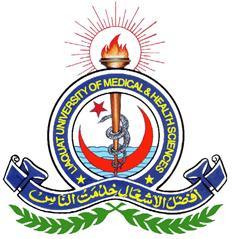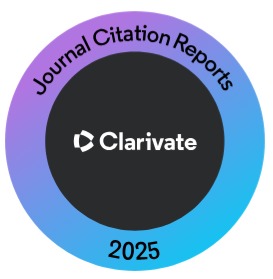Association of Dry Eye Disease and Diabetic Retinopathy with Glycated Hemoglobin at a Tertiary Care Unit of Karachi Pakistan
Keywords:
Dry eyes, ocular surface disease, Dryness in the eyes, deficiency tear, lacrimal function unit, Schirmer's test, DiabetesAbstract
Objective: To investigate the association of dry eye disease and diabetic retinopathy (DR) with glycated haemoglobin at a tertiary care unit in Karachi, Pakistan.
Methodology: This cross-sectional observational study was conducted at Baqai Institute of Diabetology and Endocrinology, Baqai University Karachi, Pakistan, from July to December 2020. A total of 238 subjects having type 2, type 1, and gestational diabetes mellitus participated in this study. They went through a routine ophthalmic examination, breakup tear film time (BUT) test, Schirmer I test, staining fluorescein, and fundus photography performed to diagnose the DR. Baseline detail and biochemical parameters were recorded. Data analysis was done on statistical packages for the sciences social (SPSS) 20 version.
Results: A total of 72 participants had dry eye disease (DED) conforming to a total prevalence of 30.25%; 11(4.6%) had severe dry eyes, 26(10.9%) had moderate dry eyes, 35(14.7%) had mild dry eyes whereas, 166(69.7%) participants had normal eyes. There was no significant association between gender, index mass body (BMI), smoking habits, history of family diabetes, and duration of Diabetes with DED. The frequency of diabetic retinopathy (DR) was registered as 23.5%; 29(24%) males and 27(23.1%) females, respectively.
Conclusion: Overall, a 30.3% frequency of dry eye in diabetic individuals was observed. It should improve by having consistent follow-ups after three to six months, providing a distinct difference in the condition compared to the non-affected individuals.
References
Federation ID. Diabetes facts & figures. International Diabetes Federation. Available at: Available at: https://idf.org › About Diabetes › What is Diabetes. [Last accessed on 12-Sept-2021].
Basit A, Fawwad A, Qureshi H, Shera AS, NDSP Members. Prevalence of Diabetes, pre-diabetes and associated risk factors: Second National Diabetes Survey of Pakistan (NDSP), 2016–2017. BMJ Open. 2018; 8: e020961. doi: 10.1136/bmjopen-2017-020961.
Chou CY, Hsu DY, Chou CH. Predicting the Onset of Diabetes with Machine Learning Methods. J Pers Med. 2023; 13(3): 406. doi: 10.3390/jpm13030406.
Mumtaz SN, Fahim MF, Arslan M, Shaikh SA, Kazi U, Memon MS. Prevalence of diabetic retinopathy in Pakistan; A systematic review. Pak J Med Sci. 2018; 34(2): 493-500. doi: 10.12669/pjms.342.13819.
Zou X, Lu L, Xu Y, Zhu J, He J, Zhang B et al. Prevalence and clinical characteristics of dry eye disease in community-based type 2 diabetic patients: the Beixinjing eye study. BMC Ophthalmol. 2018; 18(1): 117. doi: 10.1186/s128 86-018-0781-7.
Midhuna K, Divya N, Veeramani PA, Bhaskaran B. Assessment of the incidence and prevalence of dry eyes in diabetic individuals and its effect on visual acuity. Int J Curr Pharm Res. 2020; 12(6): 97-99. doi: 10.22159/ijcpr.2020v126.40301.
Zhang X, Zhao L, Deng S, Sun X, Wang N. Dry eye syndrome in patients with diabetic mellitus: prevalence, etiology and clinical characteristics. J Ophthalmol. 2016; 2016. doi: 10.1155/2016/ 8201053. Epub 2016 Apr 26.
Kesarwani D, Rizvi SWA, Khan AA, Amitava AK, Vasenwala SM, Siddiqui Z. Tear film and ocular surface dysfunction in Diabetes mellitus in an Indian population. Indian J Ophthalmol. 2017; 65(4): 301-4. doi: 10.4103/ijo.IJO_939_15.
Kamel SS, Mohammed TH, El Zankalony YA, Saad AH. Prevalence of dry eyes in diabetics. J Egyptian Ophthalmol. 2017; 110: 77-82.
Long M, Wang C, Liu D. Glycated hemoglobin A1C and vitamin D and their association with diabetic retinopathy severity. Nutr Diabetes. 2017; 7(6): e281. doi: 10.1038/nutd.2017.30.
Mohmond AJ. Treatment of Dry Eye: comparing the use of Tears Naturale Eye Drop, Omega 3, Physical Treatment and Exercises (Doctoral dissertation, Alneelain University). 2014.
Fawwad A, Waris N, Basit KA, Tahir B, Gregg EW, Basit A. NDSP-10: The Cardiometabolic Risk Profile with Various Degrees of Dysglycemia in Younger and Older Adults: Findings from the Second National Diabetes Survey of Pakistan 2016–2017. Metab Syndr Relat Disord. 2022; 20(6): 351-59. doi: 10.1089/met.2021.0154. Epub 2022 May 26.
Basit A, Sabir S, Riaz M, Fawwad A, NDSP Members. NDSP 05: Prevalence and pattern of dyslipidemia in urban and rural areas of Pakistan; A sub-analysis from second National Diabetes Survey of Pakistan (NDSP) 2016–2017.
J Diabetes Metab Disord. 2020; 19(2): 1215-25. doi: 10.1007/s40200-020-00631-z.
Pan WH, Yeh WT. How to define obesity? Evidence-based multiple action points for public awareness, screening, and treatment: an extension of Asian-Pacific recommendations. Asia Pac J Clin Nutr. 2008; 17(3): 370-4.
Basit A, Tanveer S, Fawwad A, Naeem N, NDSP Members. Prevalence and contributing risk factors for hypertension in urban and rural areas of Pakistan; a study from second National Diabetes Survey of Pakistan (NDSP) 2016–2017. Clin Exp Hypertens. 2020; 42(3): 218-24. doi: 10.1080/ 10641963.2019.1619753. Epub 2019 May 31.
Fuerst N, Langelier N, Massaro-Giordano M, Pistilli M, Stasi K, Burns C et al. Tear osmolarity and dry eye symptoms in diabetics. Clin Ophthalmol. 2014; 8: 507-15. doi: 10.2147/OPTH. S51514.
Beckman KA. Characterization of dry eye disease in diabetic patients versus non-diabetic patients. Cornea. 2014; 33(8): 851-4. doi: 10.1097/ICO.0000000000000163.
Misra SL, Craig JP, Patel DV, McGhee CN, Pradhan M, Ellyett K et al. In vivo confocal microscopy of corneal nerves: an ocular biomarker for peripheral and cardiac autonomic neuropathy in type 1 diabetes mellitus. Invest Ophthalmol Vis Sci. 2015; 56(9): 5060-5. doi: 10.1167/iovs.15-16711.
Achtsidis V, Eleftheriadou I, Kozanidou E, Voumvourakis K, Stamboulis E, Theodosiadis PG et al. Dry eye syndrome in subjects with Diabetes and association with neuropathy. Diabetes Care. 2014; 37(10): e210-1. doi: 10.2337/dc14-0860.
Ramos-Remus C, Suarez-Almazor M, Russell AS. Low tear production in patients with Diabetes mellitus is not due to Sjögren's syndrome. Clin Exp Rheumatol. 1994; 12(4): 375-380.
ul Islam Q, Mehboob MA, Amin ZA. Comparison of corneal morphological characteristics between diabetic and nondiabetic population. Pak J Med Sci. 2017; 33(6): 1307-1311. doi: 10.12669/pjms. 336.13628.
Sagdik HM, Ugurbas SH, Can M, Tetikoglu M, Ugurbas E, Ugurbas SC et al. Tear film osmolarity in patients with diabetes mellitus. Ophthalmic Res. 2013; 50(1): 1-5. doi: 10.1159/000345770. Epub 2013 Feb 22.
He F, Zhao Z, Liu Y, Lu L, Fu Y. Assessment of Ocular Surface Damage during the Course of Type 2 Diabetes Mellitus. J Ophthalmol. 2018; 2018: 1206808. doi:10.1155/2018/1206808.
Nadeem H, Malik TG, Mazhar A, Ali A. Association of Dry Eye Disease with Diabetic Retinopathy. J Coll Physicians Surg Pak. 2020; 30(5): 493-7. doi:10.29271/jcpsp.2020.05.493.
Khetwani D, Karambelkar VH, Gadre GA. Ocular surface disorders in type 2 diabetes mellitus. Int J Contemp Med Res. 2019; 6(3): C9-C12. doi: 10.21276/ijcmr.2019.6.3.41.
Najafi L, Malek M, Valojerdi AE, Aghili R, Khamseh ME, Fallah AE et al. Dry eye and its correlation to Diabetes microvascular complications in people with type 2 diabetes mellitus. J Diabetes Complications. 2013; 27(5): 459-62. doi: 10.1016/j.jdiacomp.2013.04.006. Epub 2013 May 30.
Manjula TR, Gahana K, Harsha R. A Clinical Study on Meibomian Gland Dysfunction and Dry Eye in Patients with Type2 Diabetes Mellitus. J Med Sci Health. 2019; 5(3): 7-12.
Waris SA, Balaji RSN, Huda R. To study prevalence of dry eyes in diabetic patients. Indian J Clin Exp Ophthalmol. 2019; 5: 40-43. doi: 10.18231/2395-1451.2019.0010.
Downloads
Published
How to Cite
Issue
Section
License
Copyright (c) 2023 Journal of Liaquat University of Medical & Health Sciences

This work is licensed under a Creative Commons Attribution-NonCommercial-ShareAlike 4.0 International License.
Submission of a manuscript to the journal implies that all authors have read and agreed to the content of the undertaking form or the Terms and Conditions.
When an article is accepted for publication, the author(s) retain the copyright and are required to grant the publisher the right of first publication and other non-exclusive publishing rights to JLUMHS.
Articles published in the Journal of Liaquat University of Medical & health sciences are open access articles under a Creative Commons Attribution-Noncommercial - Share Alike 4.0 License. This license permits use, distribution and reproduction in any medium; provided the original work is properly cited and initial publication in this journal. This is in accordance with the BOAI definition of open access. In addition to that users are allowed to remix, tweak and build upon the work non-commercially as long as appropriate credit is given and the new creations are licensed under the identical terms. Or, in certain cases it can be stated that all articles and content there in are published under creative commons license unless stated otherwise.























